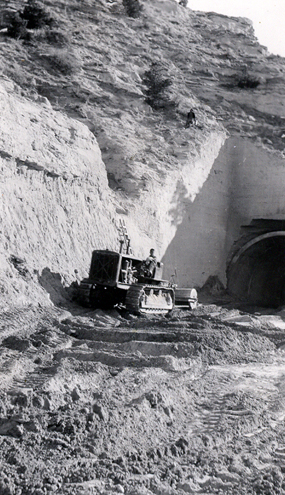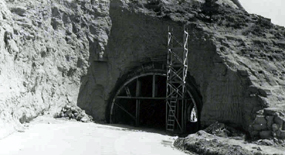
Not having received a positive response from the federal government, concerned citizens submitted a petition to the National Park Service on October 5, 1916, in which they urged that a national monument commemorating the Oregon Trail be set aside. In March of 1918, a second petition was submitted, and their persistence paid off. On December 12, 1919, Woodrow Wilson signed a Presidential Proclamation, which officially established Scotts Bluff National Monument.
The monument's first Superintendent, or as their were called in those days, "Custodian," was Will Maupin, editor of the Gering Midwest newspaper. He served from 1920 until 1924 at a salary of $1 per month. With the aid of donations, Maupin was able to construct a picnic area at the base of the eastern face of the bluff. He was also able to make imporvements on a hiking path to the summit, and was the first to suggest that a paved road to the summit be built, along with what he termed an "amusement resort."
The monument's second Custodian was Albert Mathers, President of the Gering National Bank, and he served from 1925 until 1934. Thanks to his energetic leadership, in 1926 new tables were added to the picnic area. Using the labor of local Boy Scouts, a new hiking path from the picnic area to the summit, which came to be known as the Zig-Zag Trail, was completed in June of 1927.
 In 1928, the picnic area received further improvements when it was provided with electric power and streetlights, and in 1930 a Memorial Arch was constructed. A high point in Custodian Mathers' efforts to develop the monument came on June 16, 1931, when Horace Albright, Director of the National Park Service visited the site. Impressed by what he had seen, on a second visit in 1932, Albright promised to support the construction of the summit road.
In 1928, the picnic area received further improvements when it was provided with electric power and streetlights, and in 1930 a Memorial Arch was constructed. A high point in Custodian Mathers' efforts to develop the monument came on June 16, 1931, when Horace Albright, Director of the National Park Service visited the site. Impressed by what he had seen, on a second visit in 1932, Albright promised to support the construction of the summit road.
Within a few months the first federal money was allocated to begin work on the Summit Road. Excavation of the lower tunnel and parking area, and construction of a connected hiking trail was assigned to a private contractor. Unfortunately, at this same time, a surveyor discovered that the previously developed picnic area had been mistakenly build outside the monument's boundary!
For a short time, construction efforts came under the guidance of an agency known as the Civil Work Administration, which continued until April 28, 1934, when all construction came to a stop. At this time a complete survey was conducted to identify the bluff's historic and natural resources and to determine its future needs.
During this survey, Dr. Harold J. Cook was named the monument's first ranger and on December 20, 1934, another federal agency, the Public Works Administration funded some work on the road to the summit, as well as planning for the new museum.
Development at Scotts Bluff National Monument began in earnest with the arrival of Company 762 of the Civilian Conservation Corps. In April of 1935, these civilian laborers, under the leadership of Army officers, assumed responsibility for completing the summit road and work on new picnic grounds. Work on the first wing of the Oregon Trial Museum was assigned to the Fullen Construction Company in the fall of 1935.
Charles Randels succeeded Cook on July 15, 1935, as Scotts Bluff's fourth Custodian. Before leaving on June 25, 1938, Randels oversaw the completion of the tunnels and the paving of the Summit Road in 1937. The Oregon Trail Museum was dedicated on July 16, 1936, and the Summit Road was opened to the public on September 19, 1937.